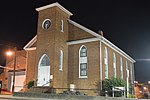The Battle of Cumberland Church was fought on April 7, 1865, between the Union Army's II Corps of the Army of the Potomac and the Confederate Army of Northern Virginia during the Appomattox Campaign of the American Civil War.
After the Battle of Sailor's Creek on April 6, 1865, surviving Confederate troops of Lieutenant General Richard H. Anderson and Major General John B. Gordon headed for the High Bridge, a double-deck structure with a railroad bridge on top and a lower wagon road bridge over the Appomattox River to cross to the north side of the river and continue their retreat to the west. The Confederates intended to destroy the bridge, which they had fought to save the day before in the Battle of High Bridge, but through mistakes and delays did not start to do so until Union troops of Major General Andrew A. Humpreys's II Corps began to arrive at the bridges. After a second smaller Battle of High Bridge, the Union soldiers at the scene kept the railroad bridge from total destruction and saved the wagon bridge in shape for use.
Humphreys's troops pursued the last division in the line of march, the division of Major General William Mahone to Cumberland Church about 4 miles (6.4 km) to the west and 3 miles (4.8 km) north of Farmville, Virginia where the Confederates began to fortify the high ground around the church. Soon, Lieutenant General James Longstreet with the entire remaining Confederate infantry moved up from Farmville, Virginia to join Mahone, burning the railroad and wagon bridges at Farmville after them. The Confederate cavalry and one infantry brigade that were left behind had to ford the river nearby.
After some fighting in transit to Cumberland Church in which Brigadier General Thomas A. Smyth was mortally wounded, Humphreys ordered his two divisions, which reached the church soon after Mahone, to attack the Confederate line. Finding the Confederate position too strong to take, Humphreys recalled Brigadier General Francis Barlow's division, which had been heading directly to Farmville in pursuit of Gordon's corps, and sent a message to Army of the Potomac commander Major General George Meade that Lee's whole army was north of the river. Humphreys suggested that reinforcements be sent in order to engage the full Confederate Army. Neither Humphreys nor Meade knew until later that the Confederates had destroyed the bridges at Farmville and no reinforcements could reach Humphreys that afternoon.
Mistaking a separate nearby cavalry engagement as the arrival of reinforcements engaging with Lee's infantry, Humphreys ordered another futile attack, which was repulsed by the Confederates. Colonel (Brevet Brigadier General) John Irvin Gregg was taken prisoner by the Confederates in the cavalry engagement. Since no reinforcements could quickly reach Humphreys and night was approaching, Humphreys ordered no further attacks. The II Corps had at least 571 casualties in the Battle at Cumberland Church and the cavalry had 74 in what is sometimes called the Battle of Farmville. Confederate casualties are unknown but have been estimated to be about half the number of the Union casualties. The National Park Service gives the number of Confederate casualties as 255.
Realizing that the Union forces could close in on his men at Cumberland Church, General Robert E. Lee withdrew his army in another night march to the west at about 11:00 p.m. Although the Confederates held back the Union Army at Cumberland Church and had fewer casualties, they were delayed in their march, which helped other Union forces south of the Appomattox River to pass them and cut them off at the Battle of Appomattox Court House.






